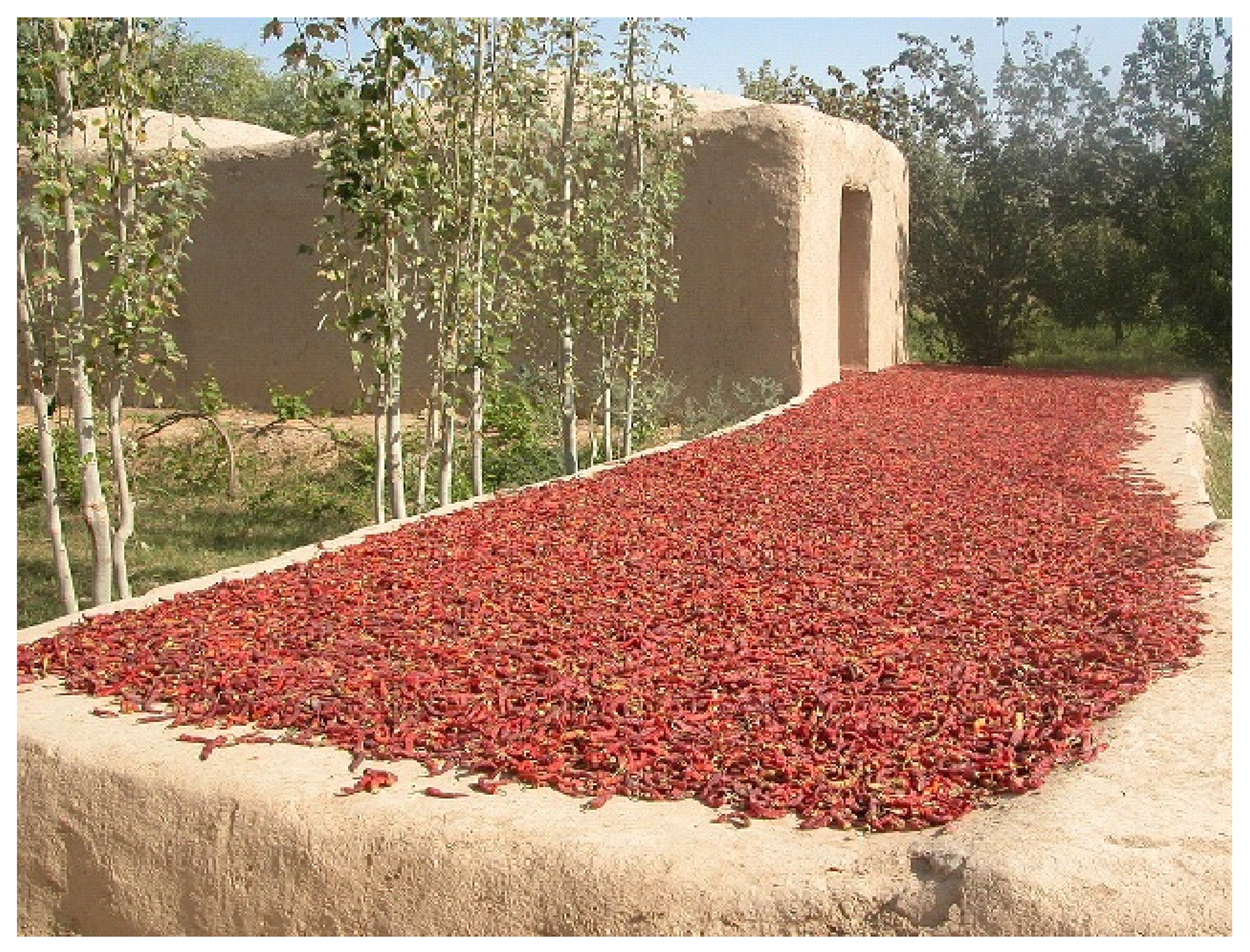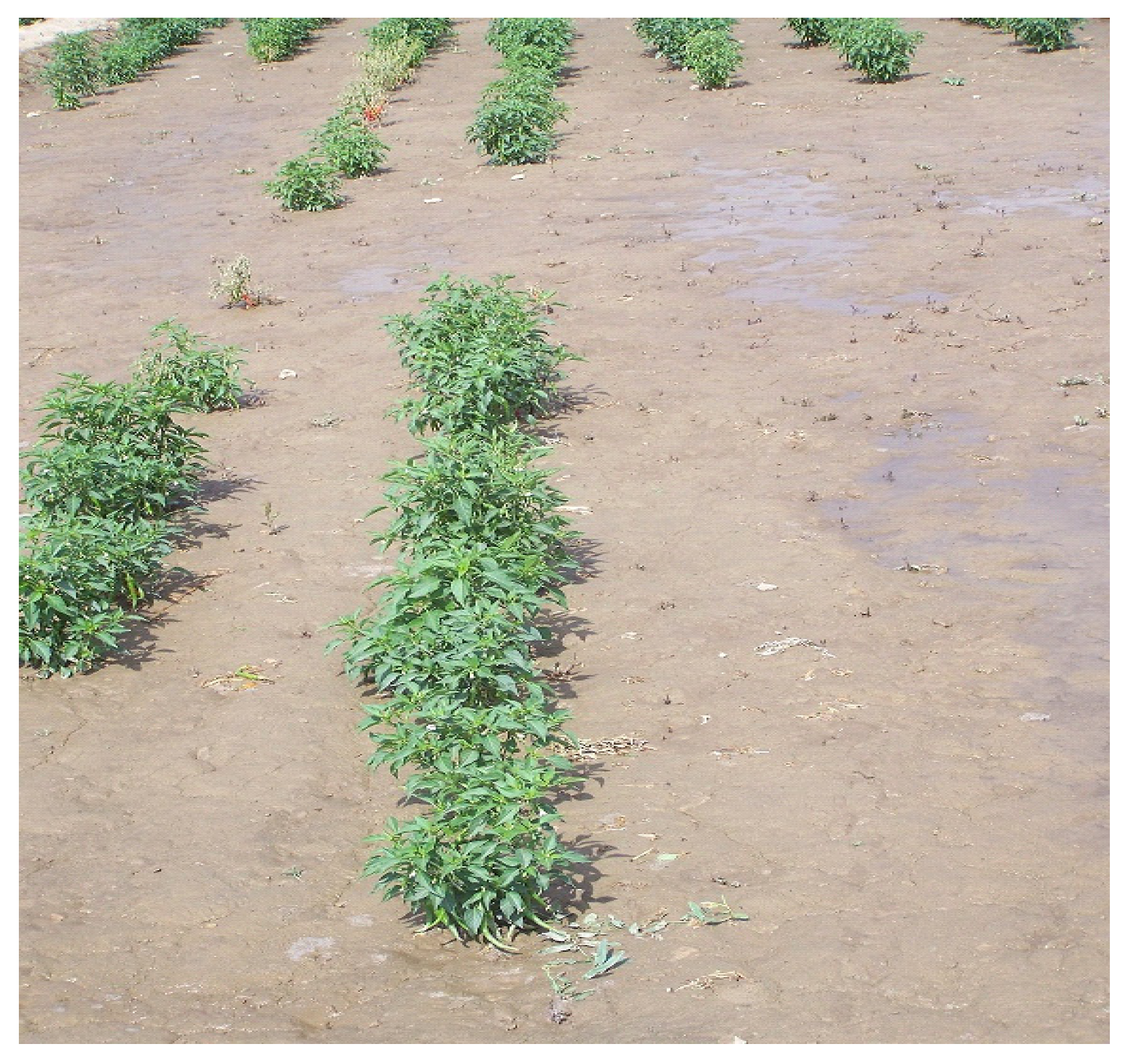Sustaining Chili Pepper Production in Afghanistan through Better Irrigation Practices and Management
Abstract
:1. Introduction
2. Materials and Methods
2.1. Field Experiment Location, Setup, and Maintenance
2.2. Data Collection
2.3. Data Analysis
3. Results
3.1. Statistical Analyses
3.2. Chili Pepper Growth and Yield
3.3. Phytophthora Blight Disease Incidence
3.4. Water Utilization and WUE
4. Discussion
4.1. Water Management and Utilization in Afghanistan
4.2. Crop WUE in Afghanistan and Associated Problems
4.3. Drip versus Furrow Irrigation Systems
5. Conclusions
Acknowledgments
Author Contributions
Conflicts of Interest
References
- De Wrachien, D.; Goli, M.B. Global warming effects on irrigation development and crop production: A world-wide view. Agric. Sci. 2015, 6, 734–747. [Google Scholar] [CrossRef]
- Walters, S.A.; Groninger, J.W. Water distribution systems and on-farm irrigation practices: Limitations and consequences for Afghanistan’s agricultural productivity. Water Int. 2014, 39, 348–359. [Google Scholar] [CrossRef]
- Torell, G.L.; Ward, F.A. Improved water institutions for food security and rural livelihoods in Afghanistan’s Balkh river basin. Int. J. Water Res. Dev. 2010, 26, 613–637. [Google Scholar] [CrossRef]
- Thomas, V.; Ramzi, A.M. SRI contributions to rice production dealing with water management constraints in northeastern Afghanistan. Paddy Water Environ. 2011, 9, 101–109. [Google Scholar] [CrossRef]
- Walters, S.A.; Groninger, J.W.; Myers, O. Rebuilding Afghanistan’s agricultural economy: Vegetable production in Balkh province. Outlook Agric. 2012, 41, 7–13. [Google Scholar] [CrossRef]
- Qureshi, A.S. Water Resources Management in Afghanistan: The Issues and Options; Working Paper 49, Pakistan Country Series 49; International Water Management Institute (IWMI): Columbo, Sri Lanka, 2002; 25p. Available online: https://cropwatch.unl.edu/documents/Water%20Resource%20Issues%20In%20Afghanistan.pdf (accessed on 20 August 2016).
- Dagdelen, N.; Yilmaz, E.; Sezgin, F.; Gürbüz, T. Effects of water stress at different growth stages on processing pepper (Capsicum annum cv. Kapija) yield, water use and quality characteristics. Pak. J. Biol. Sci. 2004, 7, 2167–2172. [Google Scholar]
- Walters, A.; Hughes, C. Chili Pepper Information Sheet for Afghanistan; Univ. California Regents: Davis, CA, USA, 2004; Available online: http://afghanag.ucdavis.edu/a_horticulture/row-crops/peppers/IS_Chili_Peppers.pdf (accessed on 20 August 2016).
- Valipour, M. Evolution of irrigation-equipped areas as share of cultivated areas. Irrig. Drain. Syst. Eng. 2013. [Google Scholar] [CrossRef]
- Valipour, M. Necessity of irrigated and rainfed agriculture in the world. Irrig. Drain. Syst. Eng. 2013. [Google Scholar] [CrossRef]
- Locascio, S.J. Management of irrigation for vegetables: Past, present and future. HortTechnology 2005, 15, 482–485. [Google Scholar]
- Passioura, J. Increasing crop productivity when water is scarce: From breeding to field management. Agric. Water Manag. 2006, 80, 176–186. [Google Scholar] [CrossRef]
- Jha, A.K.; Malla, R.; Sharma, M.; Panthi, J.; Lakhankar, T.; Krakauer, N.Y.; Pradhanang, S.M.; Dahal, P.; Shrestha, M.L. Impact of irrigation method on water use efficiency and productivity of fodder crops in Nepal. Climate 2016. [Google Scholar] [CrossRef]
- Aujla, M.S.; Thind, H.S.; Buttar, G.S. Fruit yield and water use efficiency of eggplant (Solanum melongea L.) as influenced by different quantities of nitrogen and water applied through drip and furrow irrigation. Sci. Hortic. 2006, 112, 142–148. [Google Scholar] [CrossRef]
- Sezen, S.M.; Yazar, A.; Eker, J.L. Effect of drip irrigation regimes on yield and quality of field grown bell pepper. Agric. Water Manag. 2006, 81, 115–131. [Google Scholar] [CrossRef]
- Srinivas, K.; Hegde, D.M.; Havanagi, G.V. Irrigation studies of watermelon (Citrullus lanatus (Thunb) Matsum et Nakai). Irrig. Sci. 1989, 10, 293–301. [Google Scholar] [CrossRef]
- Tiwari, K.N.; Mal, P.K.; Singh, R.M.; Chattopadhyay, A. Response of okra (Abelmoschus esculentus L.) to drip irrigation under mulch and non-mulch conditions. Agric. Water Manag. 1998, 38, 91–102. [Google Scholar] [CrossRef]
- Tiwari, K.N.; Singh, S.; Mal, P.K. Effect of drip irrigation on yield of cabbage (Brassica oleracea L. var. capitata) under mulch and non-mulch conditions. Agric. Water Manag. 2003, 58, 19–28. [Google Scholar]
- Yuan, B.Z.; Sun, J.; Kang, Y.; Nishiyama, S. Response of cucumber to drip irrigation water under a rainshelter. Agric. Water Manag. 2006, 81, 145–158. [Google Scholar] [CrossRef]
- Imtiyaz, M.; Mgadla, N.P.; Manase, S.K.; Chendo, K.; Mothobi, E.O. Yield and economic return of vegetable crops under variable irrigation. Irrig. Sci. 2000, 19, 87–93. [Google Scholar] [CrossRef]
- USAID-AWATT. Component 1—Integrated Water Management: Laser land leveling. In USAID Afghanistan Water, Agriculture, and Technology Transfer (AWATT) Program Quarterly Report (April-May-June); USAID: Washington, DC, USA, 2010; p. 7. [Google Scholar]
- Puma, M.J.; Cook, B.I. Effects of irrigation on global climate change during the 20th century. J. Geophysical. Res. 2010. [Google Scholar] [CrossRef]



| Irrigation Method | Plant Height (cm) | Number Fruit per Plant | Yield (ton/ha) | Phytophthora Disease Incidence (%) |
|---|---|---|---|---|
| Basin | 29 b | 9 b | 5 b | 69 b |
| Drip | 49 a | 39 a | 11 a | 4 a |
| Furrow | 48 a | 38 a | 10 a | 7 a |
| Irrigation Method | Water Utilization (m3/ha) | WUE |
|---|---|---|
| Basin | 236 c | 21.2 c |
| Drip | 130 a | 84.6 a |
| Furrow | 184 b | 54.3 b |
© 2016 by the authors; licensee MDPI, Basel, Switzerland. This article is an open access article distributed under the terms and conditions of the Creative Commons Attribution (CC-BY) license (http://creativecommons.org/licenses/by/4.0/).
Share and Cite
Walters, S.A.; Jha, A.K. Sustaining Chili Pepper Production in Afghanistan through Better Irrigation Practices and Management. Agriculture 2016, 6, 62. https://doi.org/10.3390/agriculture6040062
Walters SA, Jha AK. Sustaining Chili Pepper Production in Afghanistan through Better Irrigation Practices and Management. Agriculture. 2016; 6(4):62. https://doi.org/10.3390/agriculture6040062
Chicago/Turabian StyleWalters, S. Alan, and Ajay K. Jha. 2016. "Sustaining Chili Pepper Production in Afghanistan through Better Irrigation Practices and Management" Agriculture 6, no. 4: 62. https://doi.org/10.3390/agriculture6040062
APA StyleWalters, S. A., & Jha, A. K. (2016). Sustaining Chili Pepper Production in Afghanistan through Better Irrigation Practices and Management. Agriculture, 6(4), 62. https://doi.org/10.3390/agriculture6040062





